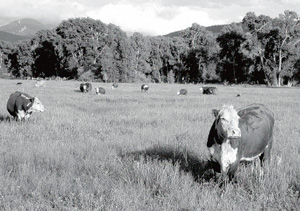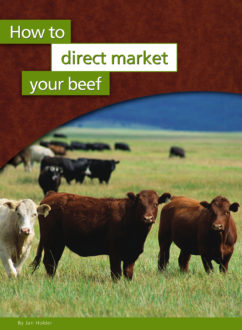
There are a ton of different breeds of cattle out there. If you read the breeds marketing literature, they all seem to “calve well, gain fast, and do great under range conditions.” Of course, if this were true, we’d only need one breed of cow. In reality, we all live in different climates, and we are all looking for certain strengths in our cattle – even more so for you as a niche marketer.
For example, meat marbling is definitely one of those personal preference issues. Some particularly health-conscious customers don’t want any marbling in their beef. Others claim their beef isn’t tender without a little fat. You’ll need to discern what most of your customers like and plan your breeds accordingly.
One more thing you also will hear is, “There are more differences within a breed than between breeds.” There is an element of truth to this. By the same token, you will never find a Zebu that marbles as well as a Wygu. The moral here again is only you will know what’s best for you. Based on what we learned about genetics and our experiences, we’ve made some basic conclusions.
Cattle that marble well:
- Angus
- Jersey
- Hereford
- Red Angus
- Highlanders
- Murry Grey
- Tarantaise
I’ve read that Highlands cattle marble very easily; they have so much hair, they don’t need any back fat and put that energy in marbling.
Leaner cattle with less marbling:
- Zebu
- Brahma
- Brangus
- Gelbvieh
- Braunvieh
I have heard that there is a strain of Brahma that is very tender. Personally, I have had very bad luck with them, as tenderness goes. Only about 4 percent have been tender enough.
The longer we are in this business, the more respect we have for genetics. Good genetics has a lot to do with the tenderness of your beef. Angus cattle can make just as many tough steaks as a Brahma. It just depends on the genetics behind them. Good genetics also has a lot to do with profitability. There is a 20-percent difference between our best cattle and our worst in the weight of our high-end cuts.
Another area we are working with is maturity. Maturity is based on frame size, but knowing when an animal has matured (and, more importantly, marbled) is as much of an art as a science. It’s just a skill you have to develop. However, there are some basics.
No matter how much you feed your animals or how good the forage is, they will not start to marble until they mature. Currently, the conventional market is looking for animals maturing at 1,200 to 1,300 pounds. This seems ludicrous. The only person to profit on such heavy weights is the feeder (who gets to sell more feed), and the packer (who gets a break by spreading his hard costs over a heavier animal).
For a grass-fed product, we are looking at something that will mature in two years or less. After about 30 months of age, you will start running into tenderness problems related solely to age (this isn’t a hard and fast rule, with good genetics we’ve been able to slaughter open three-year-olds with no tenderness problems). With that in mind, we’ve been looking to raise an animal that will mature at 800 to 1,000 pounds, a figure sort of pulled out of a hat. Maybe 600 to 800 pounds is the magic figure. We chose 800 to 1,000 pounds because it seemed do-able without getting into an extreme breeding program.
As our genetics and quality of forage improves, we are experimenting with trying to take this weight up to 1,000 to 1,100 pounds. The jury is still out on whether this is economical. If you buy calves instead of producing your own, you may want to choose the shorter frame animals that will mature at your lighter harvest weight.
Ultimately, we believe these new breeding programs will be a spin-off industry of grass-fed beef. Beef that do well in a feedlot don’t necessarily do well on grass. Special breeding lines will have to be created. Grass-fed cattle in Minnesota will be very different genetically from Florida, or Arizona, or anywhere else. We all have different situations and needs. We will all need different genetics, and someone, somewhere will supply them.
